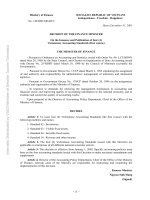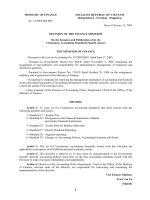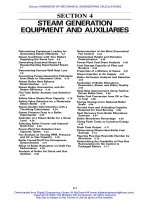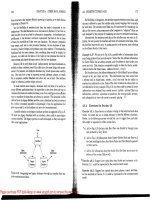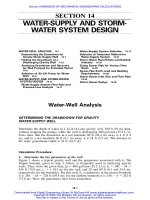Tài liệu Office of the Comptroller of the Currency Board of Governors of the Federal Reserve System pptx
Bạn đang xem bản rút gọn của tài liệu. Xem và tải ngay bản đầy đủ của tài liệu tại đây (105.89 KB, 13 trang )
1
Office of the Comptroller of the Currency
Board of Governors of the Federal Reserve System
JUNE 21, 2012 (Updated November 20, 2012)
FINANCIAL REMEDIATION FRAMEWORK
FREQUENTLY ASKED QUESTIONS
Financial Remediation Framework Approach
1. What is the purpose of the Financial Remediation Framework?
The Office of the Comptroller of the Currency (OCC) and the Board of Governors of the Federal
Reserve System (FRB) have developed the financial remediation framework (the Framework) to
provide examples of situations where compensation or other remediation is required for financial
injury due to servicer errors, misrepresentations, or other deficiencies. The independent
consultants will use the Framework to recommend remediation for financial injury identified
during the Independent Foreclosure Review. The servicers will prepare remediation plans based
on the independent consultants’ recommendations. The federal banking regulators must approve
each servicer’s remediation plan. The categories included in the Framework are not intended to
be exhaustive or to cover all possible situations or remediation options for borrowers who may
require compensation or other remediation for financial injury.
2. Will the regulators issue updates to the Framework periodically?
The OCC and FRB do not plan to make updates to the Framework. We recognize that the
independent consultants may identify other situations or remediation options that are not covered
in the Framework. In those cases, the independent consultants may recommend other
remediation or compensation for the servicers to use in preparing their remediation plans, which
will be subject to regulator approval.
3. Will the regulators issue updates to these Frequently Asked Questions periodically?
The OCC and FRB intend to update these Frequently Asked Questions (FAQs) as appropriate.
4. Can a borrower get remediation under more than one category in the Framework?
Borrowers who suffered one of the injuries in categories 1 through 4 will only receive the
remediation described under the category that provides the highest remediation amount because
the remediation is intended to cover all financial injuries related to the foreclosure process.
Where the remediation is not intended to cover all financial injuries related to the foreclosure
process, borrowers may receive remediation or compensation for more than one category if they
suffered separate injury. For example, if a borrower was never solicited for a loan modification
under category 7 and was improperly charged fees under category 13, they will receive
remediation under both categories. On the other hand, a borrower who has been wrongfully
2
denied a loan modification under category 5 will not receive $500 for a credit reporting error
under category 13 because that is already covered under category 5.
5. If the Framework is supposed to address direct financial injury, why does it include a number
of fixed dollar payments?
The fixed dollar payments approximate an amount of direct financial injury that borrowers may
have suffered as a result of a specific error. The regulators believe that payments of designated
amounts for particular types of injury will avoid the need for borrowers to provide proof of the
amount of the injury suffered and will avoid the delay and expense associated with an
examination of the particular circumstances involved in each borrower’s case. The fixed dollar
payments may over compensate borrowers for the harm they suffered in some cases.
Nonetheless, there may be some cases where a borrower believes that additional compensation is
warranted. In those cases, borrowers may pursue other available legal remedies.
6. What if the Independent Foreclosure Review finds that the servicer made an error relating to
a borrower’s loan, but the borrower did not suffer any financial injury as a result of the error?
Will they receive remediation?
If the borrower did not suffer any financial injury as a result of a servicer’s error relating to the
borrower’s loan, the borrower will not get any remediation under the Independent Foreclosure
Review. However, the servicer will have to correct any errors identified by the Independent
Foreclosure Review process.
7. Are the remediation amounts listed in the Framework fixed, or may an independent
consultant recommend a different amount or form of remedy?
The Financial Injury Framework requires fixed dollar payments for most injury categories.
These fixed dollar payments approximate an amount of direct financial injury that borrowers
may have suffered as a result of a specific error. The regulators believe that payments of
designated amounts for particular types of injury will avoid the need for borrowers to provide
proof of the amount of the injury suffered and will avoid the delay and expense associated with
an examination of the particular circumstances involved in each borrower’s case. The fixed
dollar payments may under or over compensate borrowers for the harm they suffered in some
cases, but will allow for a consistent remedy across servicers. In unique situations, and for
those categories of the framework where remediation is to be determined on a case-by-case
basis, the independent consultants have flexibility to recommend a remedy tailored to the
individual borrower’s facts and circumstances. The regulators expect that variances from the
Framework will be very infrequent.
Remediation for Violations of the Servicemembers Civil Relief Act (SCRA)
8. Are interest rate injuries related to SCRA covered under category 1?
No. Interest rate related actions that violate the SCRA are covered under category 13. Only
3
foreclosure related actions that violate the SCRA are covered under category 1.
9. For SCRA interest rate related violations, how will a correction to the servicer’s record for
excess interest accrued in error to a borrower’s account be calculated?
Where the servicer has not reduced the interest rate as requested by the borrower in violation of
the SCRA addressed by category 13, interest will be calculated from the date the servicemember
was called to military service through the earlier of the remediation date or one year after
military service ended.
Definition of “Borrower Not in Default” under the Framework
10. What is meant by “Borrower Not in Default” for category 2?
Under category 2 in the Framework, the terms of the borrower’s original mortgage or permanent
loan modification agreement will determine whether or not the borrower is considered to be in
4
default. Generally, a borrower who is current on all required payments is not considered to be in
default.
Loss Mitigation Programs
11. What is a “loss mitigation program”?
Loss mitigation programs are programs intended to assist the borrower in avoiding foreclosure or
otherwise minimize financial losses that occur as a result of foreclosure. In addition to loan
modifications, loss mitigation programs refer to such things as cash-for-keys programs, deeds-in-
lieu of foreclosure, payment plans, short sales, or loan forbearance agreements.
12. How will injuries related to loss mitigation programs such as cash-for-keys programs, deeds-
in-lieu of foreclosure or short sales be addressed under the Framework?
These injuries will be addressed under category 13 of the Framework.
13. What is a written trial-period plan under category 3?
To be covered under category 3 in the Framework, the servicer must have communicated to the
borrower a written trial-period plan that would entitle the borrower, upon full satisfaction of all
of the required elements of the written agreement (including submitting all documentation
requested and meeting all underwriting qualifications specified), to have their loan converted
into a permanent loan modification, such that the borrower would no longer be in default status
upon execution of the permanent loan modification.
14. What is a forbearance plan? What forbearance plans are covered under category 4?
A forbearance plan is typically an agreement by the servicer to postpone, reduce, or suspend
payments due on a loan for a specified period of time. These agreements are usually intended to
provide the borrower time to resolve a short-term financial impairment. Interest may continue to
accrue at the contractual note rate during the forbearance period, in which case it remains the
borrower's responsibility.
To be covered under category 4 in the Framework, the forbearance plan offered by the servicer
must be documented and include specific payment terms for a specified period of time longer
than one month. In addition, the foreclosure must have been completed before the expiration of
the specified timeframe while the borrower was meeting all requirements of the forbearance
plan.
15. For categories 3 and 4, the servicer is permitted to offset missed and unpaid principal &
interest payments and property taxes paid on behalf of the borrower, subject to certain
limitations. How will this offset be applied?
For categories 3 and 4, where the foreclosure is complete and rescission is not possible, the
servicer may reduce the remediation payment to the borrower for any missed and unpaid
5
principal & interest payments and property taxes paid on behalf of the borrower before the trial-
period plan or forbearance plan began.
For category 3a, the servicer may also reduce the remediation payment to the borrower for
missed and unpaid principal & interest payments and property taxes paid on behalf of the
borrower for the period after the failure to convert the trial-period plan to a permanent
modification. The servicer’s offset for missed and unpaid principal & interest payments after the
failure to convert the trial-period plan may not exceed the monthly payment amounts the
borrower would have owed had the conversion to a permanent modification occurred.
In all of the above situations, the servicer may only reduce remediation payments if the servicer
had not previously taken some other action to recover those same amounts, such as adding the
unpaid amounts to the principal balance of the loan, or including those amounts in a deficiency
judgment, unless the servicer also reduces the unpaid principal balance or the deficiency
judgment by an equivalent amount.
Based on Past Documentation
16. What does it mean to provide a loan modification “where permitted based on past
documentation”?
Some loan modification programs may allow the servicer to offer borrowers the modification
they should have received based entirely on previously submitted documents. In such cases,
servicers should provide borrowers the loan modification they would have previously qualified
for without requesting that the borrower submit current and/or additional information.
Rescission
17. What is meant by rescission of a foreclosure under the Framework?
Under the Framework, rescission means to unwind the foreclosure action or sale and return
ownership of the property to the borrower as applicable.
18. When is rescission of a foreclosure possible under the Framework?
For categories 1 and 2, rescission of a foreclosure is possible when the following conditions
exist:
(i) federal law, state law, judicial, and local practice permits the action;
(ii) the home has not already been transferred or sold to a third-party; and
(iii) the servicer action does not result in underwriting a new loan if the servicer lacks
legal authority to underwrite a new loan (e.g., the servicer does not currently
possess loan originator licenses from the appropriate federal or state authority) or
is not in the business of originating loans.
6
In addition to the conditions listed above for categories 1 and 2, the borrower must also
expressly indicate that they want to stay in the home or return to the home.
For categories 3, 4, and 5, rescission of a foreclosure is possible when the following conditions
exist:
(i) federal law, state law, judicial, and local practice permits the action;
(ii) the home has not already been transferred or sold to a third-party;
(iii) the servicer action does not result in underwriting a new loan if the servicer lacks
legal authority to underwrite a new loan (e.g., the servicer does not currently
possess loan originator licenses from the appropriate federal or state authority) or
is not in the business of originating loans;
(iv) the loan or related property is in the control of the servicer (versus the investor,
guarantor, or insurer);
(v) the action does not compromise the second lien position, unless the second lien is
owned by the servicer or an affiliate of the servicer; and
(vi) investor approval to modify the loan is provided where required.
In addition to the conditions listed above for categories 3, 4, and 5, the borrower must
also expressly indicate that they want to stay in the home or return to the home.
Equity Calculation
19. How is the amount of a borrower’s equity being calculated?
A borrower’s equity is calculated based on the estimated value of the borrower’s home at the
time of the servicer’s error reduced by the amount the borrower still owes on the property. The
estimated value of the borrower’s home will be calculated as follows:
(i) Where the servicer has an appraisal or broker price opinion (BPO) within 60 days
of the date of the servicer error, the appraised value or BPO value closest to the
date of the servicer error will be used;
(ii) Where the appraisal or BPO is more than 60 days from the date of the servicer
error, the appraised value or BPO value closest to the date of the servicer error
adjusted by the Case-Schiller Home Price Index (which can be found at:
indices/en/us/?indexId=spusa-cashpidff p-us ) or the Federal Home Finance
Agency (FHFA) House Price Index (HPI) (which can be found at:
to the date of the error will be used;
or
(iii) If there is no more recent appraisal or BPO available since the origination of the
loan, the estimated value of the home at the time of error will be based on the
estimated value of the home at loan origination adjusted by the Case-Schiller
index or FHFA HPI to the date of the error.
7
If the home was later sold in a foreclosure sale for an amount more than the amount the
borrower owed on the mortgage loan(s), the borrower’s equity will be reduced by this
amount if previously paid to the borrower.
Deficiency Judgments
20. What is a deficiency judgment?
Under the Framework, a deficiency judgment is a court judgment publicly recording the amount
the borrower owes to another party as a result of the borrower’s home being sold for less than the
amount the borrower owed on their mortgage.
21. What does it mean to “remedy deficiency” under the Framework?
If the amount of a deficiency judgment is incorrect, the servicer will be required to take steps to
ensure that the borrower is not responsible for payment of the erroneous portion of the deficiency
amount.
22. Why wouldn’t the regulators just require the servicer to void all deficiency judgments?
It is not always possible to void a deficiency judgment where an error has been found. For
example, there may be legal limitations on the servicer’s ability to void a deficiency judgment or
the loan may be under the control of an investor or other third party who may have rights to the
deficiency balance. Additionally, there will be cases where part of a deficiency judgment is in
error and requires remedy, but the remainder of the judgment is accurate and valid.
Excess Interest
23. What does the term correct “excess interest” mean in the Framework?
Excess interest means the interest amount accrued or charged to the borrower in error by the
servicer. Under the Framework, servicers will be required to correct any excess interest by, for
example, making corrections to the servicer record or reimbursing the borrower for excess
interest amounts paid.
Loan Modifications – Corrections for Excess Interest
24. How will excess interest be calculated for errors related to loan modifications?
Excess accrued interest will be calculated from the date the servicer committed the error until the
error is or was corrected.
8
25. How will the independent consultants determine the date the servicer committed the error for
loan modification related categories?
•
For an erroneous denial of a complete loan modification application for which the borrower
would have qualified: the date the servicer should have approved the completed file
according to the applicable program requirements.
•
For a failure to consider and approve a complete loan modification application for which the
borrower would have qualified: the date the servicer should have approved the completed file
according to the applicable program requirements.
•
For charging a higher interest rate than specified for a modification approved under the
Home Affordable Modification Program (HAMP) or other program designated by the
regulator: the effective date of the approved modification.
•
For not decisioning a loan modification made under HAMP or other program designated by
the regulator within the timeframe required by the applicable program: the date the servicer
should have approved the completed application according to the applicable program
requirements.
If the independent consultant cannot determine the exact date the error occurred, then the
independent consultant will use a reasonable approximation of the date that the error occurred to
calculate the amount of excess interest.
Loan Modification Never Offered or No Follow-up Occurred
26. What is meant by HAMP for purposes of the Independent Foreclosure Review?
For purposes of the Independent Foreclosure Review, HAMP refers to any government sponsored
HAMP program, including, for example, the Department of the Treasury Making Home
Affordable MHA HAMP, the Department of Housing and Urban Development Federal Housing
Administration FHA HAMP, the Department of Veteran Affairs VA HAMP, the Department of
Agriculture Rural Housing Authority RD-HAMP, and the Government Sponsored Enterprise
GSE HAMP programs administered by Freddie Mac and Fannie Mae.
27. What does it mean in category 6 that the servicer “never followed up to obtain complete loan
modification documents” as required under the applicable program?
Some loan modification programs, such as HAMP beginning in January 2010, require a servicer
to send the borrower a notice, or take other actions to obtain the documents needed to modify the
loan under program standards. If the independent consultant determines that a servicer
performed no required follow-up to obtain complete loan modification documents as required by
program standards, the servicer will be required to provide the remediation described in the
Framework.
9
28. What does it mean in category 7 that the servicer “never solicited borrower loan
modification option” as required under applicable program?
Some loan modification programs, such as the HAMP, require a servicer to proactively solicit
certain borrowers. If an independent consultant determines that a servicer made no effort to
solicit a borrower for a loan modification as required by HAMP or other program designated by
the regulators, the servicer will be required to provide the remediation described in the
Framework.
Credit Reporting
29. When is the servicer required to pay $500 for credit reporting errors under the Framework?
Under the Framework, the servicer must pay $500 in cases where a servicer’s erroneous negative
credit reporting in an amount of $100 or more requires that a borrower’s credit report be
corrected. However, borrowers will not receive a separate payment of $500 for credit reporting
errors where they also receive remediation under another category that is intended to cover all
financial injuries related to the foreclosure process as described in FAQ # 4.
30. Does the $500 payment for remediation of credit report errors have to be made in all cases
where the servicer must correct an erroneous credit report?
No. A servicer does not have to make the $500 payment where the total amount of erroneous
fees that have been charged to a borrower’s account by a servicer and reported to a credit bureau
is less than $100. The servicers are required, however, to make all of the needed corrections to
an individual borrower’s credit report.
31. What if the servicer made multiple errors regarding a borrower’s credit report?
The single fixed dollar payment of $500 reflects the total compensation for credit reporting
injury, even if there are multiple errors.
Erroneous Late Fees and Foreclosure Fees Actually Paid
32. What if the borrower has already paid late fees and other foreclosure fees that were
determined to be charged in error? Does the borrower get that money back?
Where the servicer charged the borrower erroneous fees and the borrower made a payment to the
servicer for such fees, the servicer will be required to reimburse the borrower directly for those
costs plus interest.
33. How will interest be calculated for payment of erroneous fees?
Interest will be calculated from the date the borrower paid the erroneous fee until the remediation
date at 3.26 percent, the average rate paid on 10-year U.S. Treasury notes from 2009 to 2011.
10
Waivers and Releases
34. Does filing a request-for-review form prevent a borrower from filing litigation or taking
other action against the servicer?
No. Submitting a request for an Independent Foreclosure Review will not preclude borrowers
from pursuing any other legal remedies available related to their foreclosure.
35. Will the Independent Foreclosure Review process require the borrower to sign a waiver to
release the servicer from any claims related to the foreclosure action in order to receive
remediation?
No. Servicers may not ask a borrower voluntarily to release any claims in order to receive
remediation payments.
However, servicers may assert in any separate litigation, or as part of future settlements related
to the servicer’s foreclosure and servicing practices, any right that may exist under applicable
law to offset the amounts received from the servicer under the Independent Foreclosure Review,
but they may only assert it in those other matters.
National Mortgage Settlement
36. Is the Independent Foreclosure Review process the same as the recently announced National
Mortgage Settlement involving the Department of Justice, the Department of Housing and Urban
Development, other federal agencies, and States Attorneys General?
No. The two actions are separate and provide different forms of remedies and relief. The
Independent Foreclosure Review process results from consent orders issued on April 13, 2011 by
the federal banking regulatory agencies against 14 large mortgage servicers for deficient
mortgage servicing and foreclosure practices. The National Mortgage Settlement, announced
and filed in federal district court earlier this year, requires five large mortgage servicers to
address mortgage loan servicing and foreclosure abuses alleged by multiple federal and state
government agencies.
37. Will a borrower be disqualified from the Independent Foreclosure Review, if they also
participate in the National Mortgage Settlement?
No. Borrowers will not be disqualified from the Independent Foreclosure Review if they also
participate in the National Mortgage Settlement.
11
38. If a borrower has received payment under the Borrower Payment Fund of the National
Mortgage Settlement, will their remediation be offset under the Independent Foreclosure
Review?
Remediation payments under the Independent Foreclosure Review will not be offset by
payments the borrower has received under the Borrower Payment Fund of the National Mortgage
Settlement.
Debt Owed by Borrower to Servicer Does Not Prohibit Participation in the Independent
Foreclosure Review
39. If a borrower was more than six months delinquent on their mortgage, can that borrower
expect remediation?
Remediation will be based on financial harm resulting from errors, misrepresentations, or other
deficiencies in foreclosure practices by the servicer whether or not the borrower was delinquent.
However, as explained in FAQ # 14, a servicer may reduce the amount of the payment by
specified amounts due to the servicer under certain circumstances.
No Remediation for Pain and Suffering
40. If a borrower has been diagnosed by a physician for depression and anxiety related to the
stress involved with the foreclosure action, can the borrower expect remediation to cover
medications and doctor bills?
No. The Independent Foreclosure Review is intended to compensate borrowers for financial
injury and does not compensate borrowers for emotional distress, pain, suffering, or other non-
financial injury.
Taxes
41. Will borrowers who receive funds from the Independent Foreclosure Review be required to
pay taxes on amounts received as compensation or other remediation?
Borrowers should be aware that compensation received from the servicer pursuant to the
Independent Foreclosure Review may have consequences with respect to their federal, state, or
local tax liability, as well as eligibility for any public assistance benefits. The regulators cannot
give advice about the impact of settlements on an individual’s tax liability or receipt of public
assistance benefits. Borrowers may wish to consult with a qualified individual or organization
about any possible tax or other consequences resulting from the receipt of payments under the
Independent Foreclosure Review.
12
Source of Remediation Funds
42. Where is the money to pay borrower claims coming from? Is any taxpayer money involved?
The servicers are financially responsible to compensate borrowers for financial injury and no
taxpayer money is involved.
Disagreement with Independent Foreclosure Review Findings
43. What can borrowers do if they disagree with the independent consultant’s decision? Is there
an appeal process?
The results of the Independent Foreclosure Review are considered final and there is no process
for appeal of either the findings or the amounts of remediation offered. The results of the
Independent Foreclosure Review are not intended to have an impact on any other options the
borrower may pursue related to their mortgage loan.
Borrowers Currently Facing Foreclosure
44. Will the Independent Foreclosure Review affect, stop, or delay a borrower’s foreclosure sale
date?
The Independent Foreclosure Review will not necessarily affect, stop, or delay the foreclosure
sale date. The regulators have, however, issued guidance to the independent consultants and
servicers to try to prevent any borrower who is receiving an independent foreclosure review from
losing their home without their file first receiving a pre-foreclosure sale review or a review by an
independent consultant. The regulators encourage borrowers who believe they have a basis to
submit a request-for-review and are facing foreclosure to submit their requests as soon as
possible. Additionally, borrowers should continue to work with their servicer to prevent a
foreclosure sale using every avenue possible.
45. If a borrower has submitted a request-for-review under the Independent Foreclosure Review
and is waiting for a response, can he or she still work with their servicer to obtain a loan
modification or other loss mitigation option in the meantime?
Yes. In fact, borrowers should continue to work with their servicer. Participating in the review
will not interfere with efforts to modify a borrower’s obligations under an existing mortgage or
to prevent a foreclosure sale. The Independent Foreclosure Review is not intended to replace
active foreclosure prevention efforts between a borrower and a servicer.
Process and Timing of Completion of Review
46. How and when will the borrower be notified of the results of the review?
Borrowers who ask for a review of their foreclosure will receive a letter advising them of the
results of the Independent Foreclosure Review. Because the review process will be a thorough
13
examination of many details and documents, the review could take a considerable amount of time
to complete. In addition, because the servicers have to submit a remediation plan to their primary
regulator for approval, the payment process may not occur immediately after completion of the
file review.
47. Could borrowers be eligible for remediation, even if they didn’t file a request-for-review?
Yes. In addition to the request-for-review process, the independent consultants are doing a
separate file review to identify borrowers who suffered financial injury due to servicer errors,
misrepresentations or other deficiencies in the foreclosure process. Servicers will be required to
compensate all injured borrowers identified as part of that file review under the Framework.
